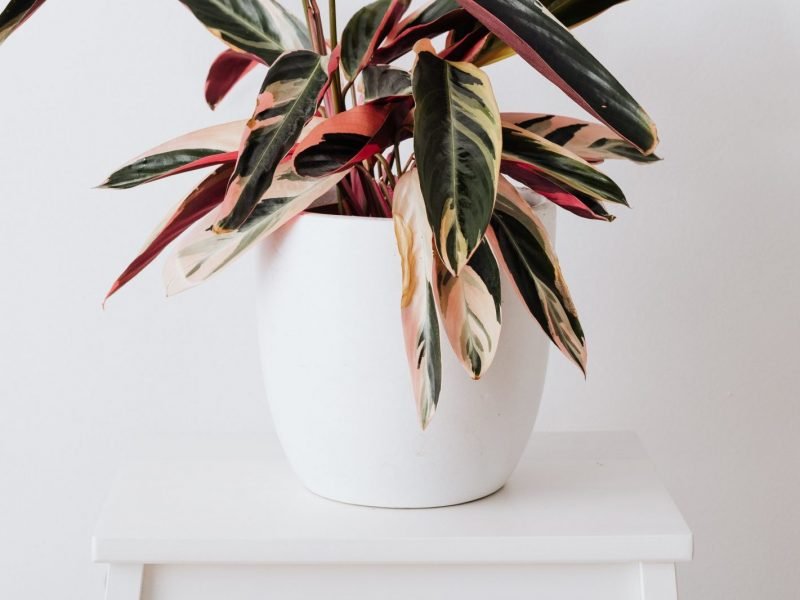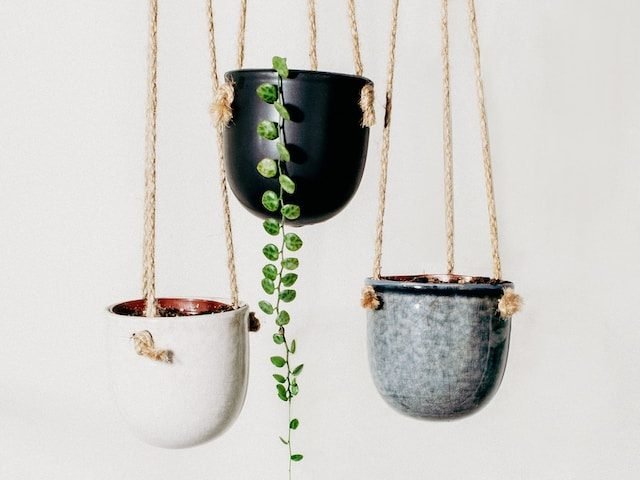
Loved for their incredible foliage, Calathea plants bring that little splash of colour into your home and have over the past few years become one of the most popular plant varieties around. Their striking leaves often mean they are a great focal point of the room which is why it can be quite worrying when their leaves start to droop. Drooping Calathea leaves might be a sign that your plant is unhappy so it’s important you look over the plant and its environment to check.
In this post, we will be going through the 4 main reasons why your Calathea has drooping leaves.
Natural praying can be confused for drooping leaves
Calathea plants naturally fold their leaves at night and uncurl them in the morning which is how the Calathea name came about. If you were to take a timelapse of your Calathea plant over 24 hours you would be shocked at how much they move! Part of this dancing means their leaves can often look a little droopy but this may just be a natural part of your Calathea’s movement.
If your plant’s leaves look a little droopy then we always recommend monitoring their position a little for a few days before making any changes to their care or environment. You don’t want to disrupt anything without knowing for sure there is a problem.
Taking photos throughout the day from the same position is a great way to monitor their movement. If you notice your Calathea’s leaves are moving around a lot over the days you are monitoring them then that is completely normal and the drooping was simply part of that natural praying and moving. However, if the leaves do not move much and are continuing to droop down and look quite limp then this is probably a sign your plant is unhappy. We cover the various issues that might be causing the drooping leaves below…
Underwatering can cause Calathea leaves to droop
The most common reason Calathea’s leaves droop down (other than natural praying) is consistent underwatering and subsequent dry potting mix. Whilst your plant can tolerate the occasional missed watering, over time if it doesn’t receive enough water then your Calathea will droop down, turn brown/yellow and eventually lose its leaves. Drooping leaves are the first sign of trouble so if you have caught the problem at this stage it’s good news as reviving your plant will be a lot easier.
There are a few quick ways to see whether your Calathea plant’s soil is dry and your plant needs watering.
- Finger or Chopstick Method
Firstly one method we often use is the finger trick where you stick a finger into the soil to see if there is any moisture in the soil. If yes, you’ll notice soil sticking to your finger when you take it out. If the soil of your Calathea is bone dry then it will just be like dust that will fall off your finger. If you don’t want to get your hands dirty then you can also use a chopstick where the same rule applies. If the chopstick comes out clean then it’s time for water (similarly to when you’re baking!).
A lot of plant parents ask us if this method won’t cause too much damage to the root system but as long as you are careful and don’t prod around too much, it should be absolutely fine. If you notice a large root in your way, try and pick a different spot rather than forcing the chopstick through as this will break the root which you’ll want to avoid.
2. Lifting your Calathea
Another way you can check the moisture levels in the soil of your Calathea is by regularly picking up your plant. This is a great method to get to know your plants and soon you’ll have a really clear gauge as to when they need more water and you can stop your plant’s leaves from drooping down.
3. Use a moisture meter
If you want to take the guesswork out of knowing when to water your Calathea (and prevent more any more drooping leaves) you can use a moisture metre. We recommend that every plant parent should own one of these as it has saved a lot of our houseplants over the years. They are super affordable little gadgets that you pop into the soil and it will literally tell you how moist the soil is. It’s that easy!!
If your Calathea’s leaves are drooping due to a lack of water, then you need to make sure to reintroduce watering in the right way. Your first instinct might be to give your drooping Calathea lots of water straight away to solve the issue but this can actually be harmful to your plant if the potting mix goes from one extreme to the other. Instead, you want to water your plant once a day for a week.
Overwatering can also cause drooping leaves
Another potential cause of drooping Calathea leaves is consistent overwatering. It’s super easy to do accidentally if you aren’t keeping an eye on the moisture levels in the soil and it can cause quite severe problems for your Calathea fairly quickly. If drooping leaves are the only thing that seems to be wrong with your plant, then this again is good news – it means that the problem is in the early stages and is often easier to fix. Other signs of overwatering include soft leaves, brown or yellow leaves and potting mix that smells damp.
The reason that overwatering is so harmful to your plant is that it causes waterlogged soil which cuts off air circulation in the potting mix. This means that the root system will begin to rot which starves your Calathea of oxygen and nutrients. It also means that the roots can’t physically support the stems anymore. The combination of these two issues is why overwatering will often cause your Calathea to droop its leaves and stems.
Before you change anything about your care routine, you need to be 100% sure that overwatering is the cause of the drooping Calathea leaves. The first thing to do is to take your plantout of its pot and inspect the potting mix and root system. If the soil feels soggy and clumpy, then this means your plant has been overwatered. If the roots are soft and mushy it suggests that this issue has been going on for a while.
How to fix an overwatered drooping Calathea
1.Replace the potting mix immediately. Don’t wait for the soil to dry out on its own as this will only make the problem worse over the next few days and you risk causing even more damage to an already rotting root system.
2. Trim off soft and mushy roots/ leaves. If your Calathea is trying to keep rotting leaves and roots alive, it will be wasting valuable energy that it could be using to recover and produce new growth.
3. Adjust your watering schedule going forward. It’s important to take a look at how often you were watering your Calathea, and how much water you were giving it each time. Cut back on one of these factors to ensure there are no more drooping leaves in future.
How to prevent overwatering (and more drooping leaves)
Now that you’ve fixed the issue for the time being and your Calathea should be on the road to recovery, let’s flip the attention to ensuring you won’t overwater your plant again and cause any more drooping leaves.
1. Only water when the potting mix is dry. There are plenty of ways to determine when it is time to water your Calathea. The most accurate of which is using a moisture meter. They are affordable little devices that you pop into the soil and it will literally tell you how damp it is. It takes all the guesswork away from watering your plants and will significantly reduce the risk of overwatering. A must-have for every plant lover!
2. Ensure good drainage. This will help solve the occasional accidental overwatering as it allows some of the water to escape. Having good drainage holes in your pot, using a well-draining potting mix that includes perlite and switching to terracotta pots are all ways you can increase the drainage for your Calathea and avoid drooping leaves.
3. Downsize your pot if necessary. One major factor when it comes to overwatering is the pot size. If your Calathea is in a pot that’s much too large for the root system, it will take much too long for the potting mix to dry out. This then increases the risk of root rot.
3. Adjust your watering schedule depending on external factors. Although watering calendars can help us remember to water our plants, they aren’t actually the best thing for our green friends and we never tend to stick to one rigidly. It’s important to adjust how much and how often you water your Calathea depending on the time of year, temperature fluctuations, sunlight levels and maturity of your plant. There’s no one fits all timeline which is why moisture metres are such a great thing for us plant parents.
Extreme temperatures can cause your Calathea to droop
If you have inspected the potting mix, and analysed your watering schedule and just can’t be sure that watering issues is the cause of the drooping leaves on your Calathea, then it may be extreme temperature fluctuations that are the problem.
Calatheas are native to the tropics of Asia and Australasia so thrive in warm temperatures meaning they’ll struggle in homes with cold air and cool drafts. You may not notice the cold air coming through cracks in doors and windows but if your plant is right next to any cold air streams then this can over time be a real issue. This is also the case with AC vents so summer can be quite problematic too.
Make sure that you draft proof any windows or doors that are close to your Calathea (and other tropical houseplants) as well as moving them away from any Ac vents. To monitor the temperature, use a digital thermometer as this will bring any cold drafts or hotspots to your attention.
Those are the 4 most common reasons why your Calathea may be drooping its leaves. It’s important to only make changes once you are sure that the drooping leaves are not simply your Calathea doing its natural dance/praying. Then start off with the potting mix as watering issues are the most common. Acting quickly will increase your chances at those leaves bouncing back so don’t hold off looking for a solution.
To find out more about how to care for your plant as well as other common issues and top tips, check out our Calathea care guides in our Plant Index.
Check out our Calathea propagation guide for a detailed step by step of how to create new plants!















